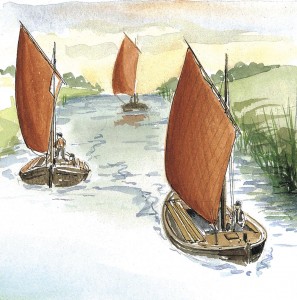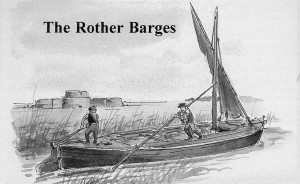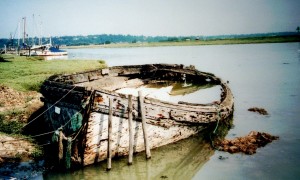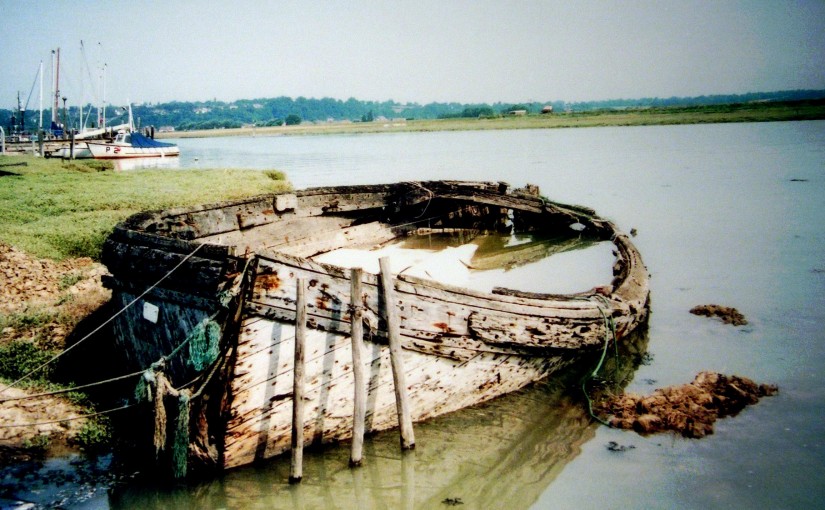Built in Rye these Shallow Draft Vessels served the towns and villages from Teterden to the north and Hythe to the East
While the rivers around Rye, the Rother, Brede and Tillingham, were, sufficiently wide and deep and the ordinary trading vessels small enough to navigate them to their destination without the necessity of any transhipment, there was no need of such a craft. Several factors, however, combined to change the situation in a drastic fashion.
The first concerns the narrowing of the rivers. When the storm of 1287 closed Romney harbour and forced the Limen which had hitherto entered the sea at New Romney, to join up with the Rother and enter the sea at Rye, the innings of the marshes commenced, notwithstanding the continuous complaints made by the maritime interests of Rye.
By 1500 East Guildeford was enclosed and by 1554 enough land had been drained to damage the harbour of the Camber. The resultant reduction of the tidal waters that had previously flowed over these parts and the consequent smaller outflow on the ebb led to the gradual siltation of the river. The Commissioners of Sewers were moved to take strong action and ordered those who had constructed dams and sluices to destroy the same forthwith. But nothing happened for several of the outlanders. who included the Mayor of Rye, were numbered among the Commissioners themselves!

Dams and sluices were also thrown up in the Tillingham and Brede rivers and according to Holloway, the Craven sluice (about 1695) reduced the “Appledore Stream” from half a mile to twenty feet in width.
By the end of the fifteenth century the original one mast square-sail type of craft had given way to the much larger two and three mast ships of a deeper draught. This fact, together with the innings of the marshes and the construction of sluices and bridges, made it impossible for such vessels to carry their consignments to such places as Smallhythe, the port of Tenterden. At first no doubt, the larger vessels made use of the smaller ones for such purposes. It was only when these smaller vessels were either broken up or sunk that the need for the barge arose. That need appears to have arisen in the fifteenth century.
The earliest record of a Marsh barge appears in 1531, when’ “Miles the lighterman of Rye was paid 4s. Id. for bringing up 6 tons of timber from Knelles Darn to Standens”, while in 1554 one John a Weke, Iighterman. was paid ‘Is. 4d. for carriage of ten tons of timber from Maythem Ferry to Rye. The earliest known drawing of a barge appears on John Prowse’s map of Rye in 1572. It would seem that the cabin was in front of the mast, which is stepped far forward in comparison with a thirteenth century ship, and the hold abaft it.
The sail is rectangular, with the head longer than the foot, the forward corner being affixed to the mast, and the after corner supported by a lone pole the lower end of which rests on the deck. The mast would be in a tabernacle so that it could be raised and lowered as the barge passed under the many wooden bridges, which at that time spanned the upper reaches of the river.

The development of a craft of this type was necessarily dictated by the gradually changing conditions of the rivers. To pass under the bridges during high tides, the stem and stern had to be flat, while the extremely shallow waters in the upper parts of the rivers prevented any increase in the laden draught. The sluices determined the length and breadth, so as to give sufficient clearance between the gates of the pound and along the sides. It is quite probable that few basic alterations were made to this type of vessel throughout its long history.
The crew of a barge consisted normally of only two men, ‘the master, who was placed in charge by the owner, and his mate. Although both men were paid the same, the master had the advantage of control and a permanent job. It was a highly skilled profession and largely ran in families with grandfathers, fathers and sons often working for the same owners. The AxelI family of Rye, for example, at one time provided three or four masters of barges, all closely related. Although the work was hard and often involved a good deal of night work, the pay was good. In 1914, when work was plentiful, the two men would earn up to 33s. a week each, while foremen were 22s., carters 18s., and agricultural labourers I2s. and a cottage worth about another Is. 6d. a week.

Mishaps were inevitable with such a vessel, working as it did in strong tide-ways and often at night. That the barges did not get damaged or sunk more often was due not only to their construction, but even more to the skill and good watermanship of their crews. Small repairs were frequently needed and thorough overhauls required from time to time. While the barges were in service, they had to be occasionally laid on a bank so that their bottoms could be scraped free from barnacles and weed and given a coat of tar. In the case of those made of iron, red paint was utilised instead of tar.
What did these barges carry? Such items as grit and shingle were transported in later years from Rye Harbour to Rye, while coal, stone, sand, shingle, oak timber, imported fir timber, bricks, manures. etc., were carried up the Rother to Bodiam and up the Brede river to Winchelsea and Brede. With the continued narrowing of the rivers and the building of further sluices, however, their trading area was gradually reduced. Between 1807 and 1875, when the Military Canal was open, navigation extended as far as Hythe and Sandgate. The Rother itself was navigable as far as Bodiam (1.6 miles) and Smallhythe (7 miles) and the barges served more intervening wharves and villages. By the nineteenth century the Brede was only navigable as far as Brede Bridge, with intervening wharves at Winchelsea and Snailham. The third Rye river, the Tillingham, could only be used in later years by the narrowest of barges which went as far as Marley Farm, serving Ferry Bridge Wharf and Leasam Farm on the way. Just before the last World War, however, a pinnock replaced the Brede sluice, thereby rendering the river unnavigable beyond the Strand Quay.

There does not appear to he any record of the names or makers of the early barges used in the district. In 1860 the “Wear”, “Hope”, “Eliza”, and “Hempsted’ were some of those owned at Rye. Between 1872 and 1875 the Rother Ironworks constructed four iron barges for Messrs. Vidler, Sons & Co. which were named
“Vulture”, “Viking”. “Victory”, and “Vulcan”. Towards the end of the last century W. F. Clark owned four barges named “Violet”, “Myrtle”. “Water lily” and “Primrose”. The “Primrose”’ was laid down in Clark’s yard in Winchelsea Road, being the last wooden barge to be built at Rye. (The Primrose is now an exhibit at the Hastings Shipwreck Museum at Rock-a-Ore).

The largest barge ever to have been built at Rye appears to have been the “Tees” which could carry as much as forty tons, while the rest were all limited to twenty and thirty tons. Just before the outbreak of the last World War there were only four barges still at work. Today they have entirely disappeared and Rye and the area they serviced is that much the poorer for the loss of those hard-working, and ‘in the old days harddrinking, hard-living, cheery people.’
Hythe & Romney Life September 2011 issue
All articles, photographs and drawings on this web site are World Copyright Protected. No reproduction for publication without prior arrangement. © World Copyright 2015 Cinque Ports Magazines Rye Ltd., Guinea Hall Lodge Sellindge TN25 6EG
